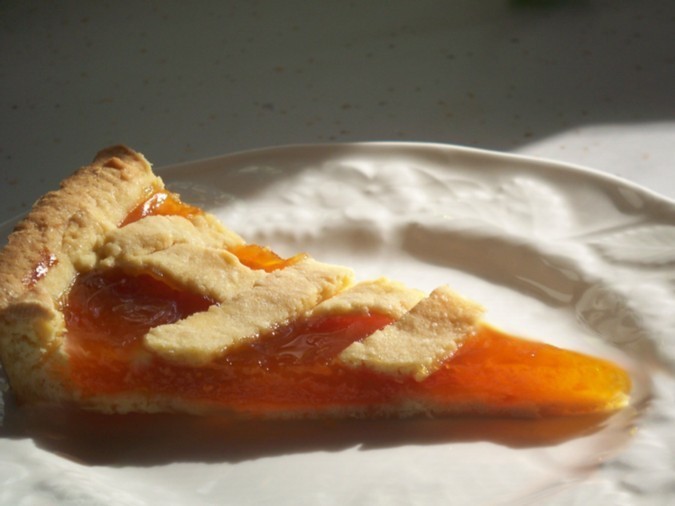The official dessert of the Commonwealth of Massachusetts: delicious Boston Cream Pie
———–
———
———

This is my entry for the blog event “A Taste of
Terroir” hosted by
Anna’s Cool Finds for which entries should highlight a specific food typical of a given area.
I write from beautiful
Massachusetts, and there are many wonderful foods that are typical of this area: from chowder to corn muffins, from cranberries to chocolate chips cookies to Parker House rolls.
——
One of my favorites is
Boston Cream Pie, which is Massachusetts
official dessert—A light sponge cake filled with vanilla cream and then iced with a dark chocolate icing, which provides a nice counterpart to the sweetness of the filling.
——–
The version I propose here is the most known, and was created in 1856 at the famous Parker House Hotel in Boston by French chef M. Sanzian. An earlier version was made without the chocolate icing and simply sprinkled on top with powdered sugar.
—
As for why it is called a “pie” while it is in fact a cake is not entirely clear, one possible explanation is that pie plates were once more common and easily available and were used to bake cakes as well.
Whether this is the actual reason for the name or not, it is indeed a delightful dessert.
—-
The recipe I used is an antique receipt and gives outstanding results—it is really worth trying.
—
Of course, if you have a chance, do visit Massachusetts and taste the Boston Cream Pie in its home State.
—
From the original recipes by Fanny L. Gillette
—————
In: “The White House Cook Book” , 1887—USA
———
Ingredients
——
Filling
—
2 cups (475 ml) whole milk
——-
2 eggs
—–
1 cup (200 g) sugar
——-
1/2 cup (60 g) flour
———
2 tbsp (30 g) butter
———
1 tsp (5 ml) pure vanilla extract or paste
—
Cake
——
3 eggs, divided
—
1 cup (200 g) sugar
—
1-1/2 cups (180 g) sifted flour
—
1 heaping tsp (6 g) baking powder
—-
2 tbsp (30 ml) milk or water
—–
Plain Chocolate Icing
—–
1 oz (30 g) bittersweet chocolate
—
3 tbsp (45 ml) milk or cream
—
1 tbsp (15 ml) water
—
scant 2/3 cup (120 g) sugar
—-
Make the Cream Filling: Scald the milk and set aside to cool. Mix together the flour and sugar, then beat the eggs and add the flour-sugar mixture, stirring until well incorporated. Add the warm milk in a thin stream, mixing well. Place on medium-low heat and cook stirring continuously, adding the butter as soon as the mixture starts to simmer. Cook the cream, always stirring to prevent scorching, until it thickens–it will offer some resistance to the spoon while you stir. Take the cream off the heat and stir in the vanilla, mixing well.
If any lumps should form, you can either strain the cream once it is ready, or blend it briefly with an immersion blender. Let the cream cool and then refrigerate it in a glass container with an airtight lid.
—
Make the Cake: Preheat the oven to 350°F (180°C). Grease two 9-inch (23 cm) cake pans, line the bottom with parchment paper, then grease the paper as well.
Sift the flour with the baking powder. Beat the egg whites until stiff and glossy, being careful not to overbeat them. Set aside.
Beat the yolks at high speed for at least 15 minutes, adding the sugar little by little until the mixture is pale yellow and thick. Add the milk or water, then add the flour-baking powder mixture little by little. Finally fold in the egg whites, making sure not to deflate them. Divide the batter between the prepared pans and bake for about 20-25 minuets, until golden. Let the cakes cool in the pans for five minutes, then unmold them and let them finish cooling on racks.
When the cakes are cold, assemble the cake: spread a thick layer of cream on top of one of the cakes, then place the second one on top.
—-
Make the Chocolate Icing: Melt the chocolate on very low heat, then mix in the cream or milk and the water, finally adding the sugar little by little. Place on low heat and mix until the sugar is dissolved. If any sugar granules adhere to the sides of the pan, wash them off with a pastry brush dipped in cold water, or the icing will be grainy. Stir the mixture until it starts to boil, then let it cook, without stirring, for five minutes. Immediately pour the hot chocolate icing on top of the cake, starting form the center and letting the icing fall down the sides. Do not use a spatula to spread the icing or it won’t be glossy. The icing hardens quickly, so you need to be fast pouring it on the cake.
—
Let the icing set, then place the cake in the refrigerator in a closed container large enough that the lid does not touch the top of the cake. Serve the cake slightly chilled.
——
 Eva from Sweet Sins is the host of bread baking day #06, for which she chose “bread shapes” as a theme.
Eva from Sweet Sins is the host of bread baking day #06, for which she chose “bread shapes” as a theme. then fold into thirds (business letter fold). Roll the dough again and fold in thirds two more times, letting the dough rest a few minutes every time. The same as you would do with croissants dough.
then fold into thirds (business letter fold). Roll the dough again and fold in thirds two more times, letting the dough rest a few minutes every time. The same as you would do with croissants dough.

 Flatten a round portion of dough (1-1/2 oz–45 g) to resemble a “8” shape. Roll the rounded sides to enlarge them, then roll each side toward the center. Finally invert the roll so that the center strip is on top.
Flatten a round portion of dough (1-1/2 oz–45 g) to resemble a “8” shape. Roll the rounded sides to enlarge them, then roll each side toward the center. Finally invert the roll so that the center strip is on top.


 Flatten a portion of dough (1-1/2 oz–45 g) into a round, then roll it into a sharp oval shape. Roll it up starting at one of the narrow ends, then elongate the rolled up dough rolling it under the palms of your hands, making sure the ends are well tapered. Finally curve it into a round, resembling a horseshoe.
Flatten a portion of dough (1-1/2 oz–45 g) into a round, then roll it into a sharp oval shape. Roll it up starting at one of the narrow ends, then elongate the rolled up dough rolling it under the palms of your hands, making sure the ends are well tapered. Finally curve it into a round, resembling a horseshoe. (click on the thumbnail to enlarge)
(click on the thumbnail to enlarge)















